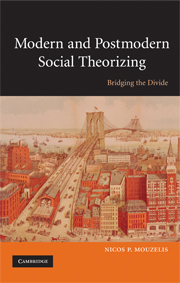Book contents
- Frontmatter
- Contents
- List of figures
- Acknowledgements
- Introduction
- Part I The theoretical background: the development of the agency–structure problematic
- Part II Parsonian and post-Parsonian developments
- Part III Agency and structure: reworking some basic conceptual tools
- Part IV Bridges between modern and late/postmodern theorizing
- Part V Towards a non-essentialist holism
- Instead of Conclusion: Twelve rules for the construction of an open-ended holistic paradigm
- Appendix: In defence of ‘grand’ historical sociology
- References
- Index
Instead of Conclusion: Twelve rules for the construction of an open-ended holistic paradigm
Published online by Cambridge University Press: 05 June 2012
- Frontmatter
- Contents
- List of figures
- Acknowledgements
- Introduction
- Part I The theoretical background: the development of the agency–structure problematic
- Part II Parsonian and post-Parsonian developments
- Part III Agency and structure: reworking some basic conceptual tools
- Part IV Bridges between modern and late/postmodern theorizing
- Part V Towards a non-essentialist holism
- Instead of Conclusion: Twelve rules for the construction of an open-ended holistic paradigm
- Appendix: In defence of ‘grand’ historical sociology
- References
- Index
Summary
In the volume's last part, in an attempt to overcome obstacles and to establish bridges between the more conventional, holistically oriented macro-sociology and the radical anti-essentialism of late/postmodern theorizing, I spelled out the preconditions for a non-essentialist holism in the social sciences. These preconditions can be summarized in terms of twelve rules which are necessary for the construction of an open-ended conceptual framework – open-ended along the actor–structure, the micro–macro and the inter-institutional dimensions.
The actor–structure dimension: anti-conflationist holism
(1) From a methodological/perspectival rather than a philosophical/ontological position, actors and structures must be viewed as analytically distinct entities. There should be neither conflation nor transcendence of the actor–structure, subjectivist–objectivist divide. Although structures do not constitute essences and although they are symbolically constructed, their causality is different from that of actors. Structural causality refers to enablements and constraints that actors face in specific social contexts, whereas actors' causality entails decision-making, agentic powers.
(2) Social wholes must be viewed both from a social-integration (internalist) and a system-integration (externalist) perspective – both as a figuration of actors establishing conflictual or co-operative relationships with each other, and as a system of role/institutional complexes portraying varying degrees of compatibility or incompatibility with each other.
(3) Structures, as sets of interrelated elements, constitute internal as well as external environments of action which set limits and create opportunities for situated actors. The former refer to internalized dispositions, whereas the latter refer to institutional, figurational, symbolic and material configurations.
- Type
- Chapter
- Information
- Modern and Postmodern Social TheorizingBridging the Divide, pp. 274 - 278Publisher: Cambridge University PressPrint publication year: 2008



